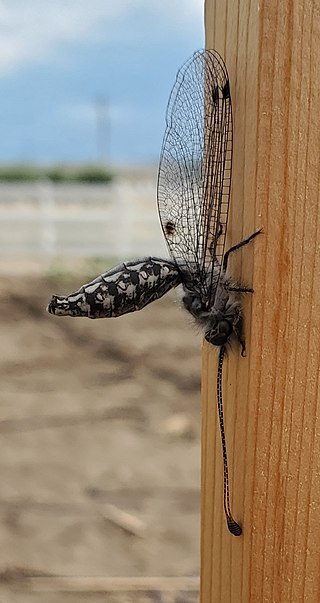
Bandwings, or band-winged grasshoppers, are the subfamily Oedipodinae of grasshoppers classified under the family Acrididae. They have a worldwide distribution and were originally elevated to full family status as the Oedipodidae. Many species primarily inhabit xeric weedy fields, and some are considered to be important locusts:

The family Leptoceridae are a family of caddisflies often called "long-horned caddisflies". Leptoceridae is the second largest family of caddisflies with more than 1500 species in around 45 genera. The main identifying feature of most Leptoceridae is that their antennae are longer than those of other caddisflies. There is one genus with short antennae (Ceraclea), but it is easily identified by the pair of dark curved lines on the mesonotum.

Rhinocypha is a genus of damselflies in the family Chlorocyphidae.

Stenobothrus is a genus of grasshoppers found in Asia, Europe, and North Africa.

Ascalaphinae is the type subfamily of the neuropteran owlfly family. Most species are found in the tropics. Their characteristic apomorphy, shared with the Ululodinae, is the ridge which divides each of their large compound eyes; both groups are thus sometimes known as split-eyed owlflies.

Ascalaphus sinister is a species of owlfly from northern India. The thorax is covered in brown hairs, with yellow markings on the sides and ventral surface and a yellow stripe running down the dorsum. The head is yellow and covered in white hairs, with some black hair on the vertex. The antennae are rust red and not as long as the wings. The elongate abdomen is saffron yellow with two black stripes down the back and a number of black streaks along the sides. Legs are yellow. The vagina in females is short and wide. The bursa copulatrix and receptaculum seminis are relatively proximate, with the latter being sclerotized and wrinkled.
Cordulecerus is a genus of owlflies, neuropteran insects in the subfamily Ascalaphinae. Species are found in Central and South America.

Sympherobius is a genus of brown lacewings in the family Hemerobiidae. There are at least 50 described species in Sympherobius.

Ululodes is a genus of owlflies in the tribe Ululodini. There are 26 described species in Ululodes.

Apatania is a genus of caddisflies in the family Apataniidae. There are at least 90 described species in Apatania.

Mystacides is a genus of long-horned caddisflies in the family Leptoceridae. There are more than 20 described species in Mystacides.

Macrostemum is a genus of netspinning caddisflies in the family Hydropsychidae. There are at least 90 described species in Macrostemum.

Anisocentropus is a genus of caddisflies in the family Calamoceratidae. There are more than 60 described species in Anisocentropus.

Archichauliodes is a genus of fishflies in the family Corydalidae. There are more than 20 described species in Archichauliodes.

Euphaea is a genus of damselflies in the family Euphaeidae. There are more than 30 described species in Euphaea, found mainly in Indomalaya.

Libelloides macaronius is a day-flying owlfly species of Europe and Asia. The genus belongs to the family Ascalaphidae, subfamily Ascalaphinae. The species has appeared on postage stamps of Moldova and Ukraine.

Heoclisis is a genus of cave-dwelling antlions, that is, insects in the family Myrmeleontidae.
Douglas Eric Kimmins was a British entomologist.
















